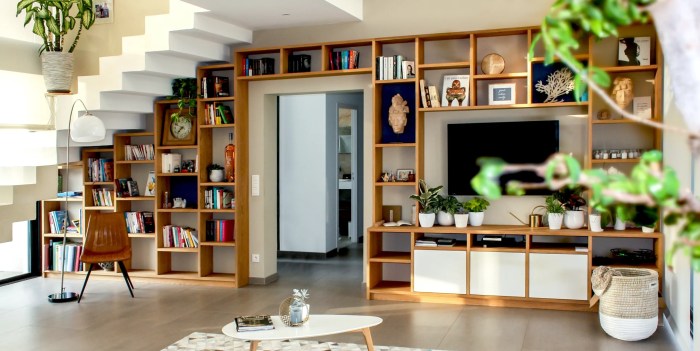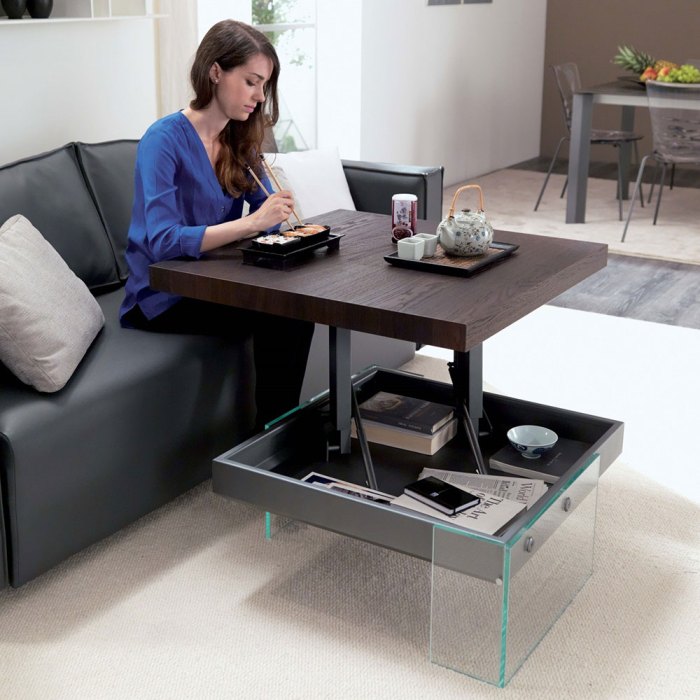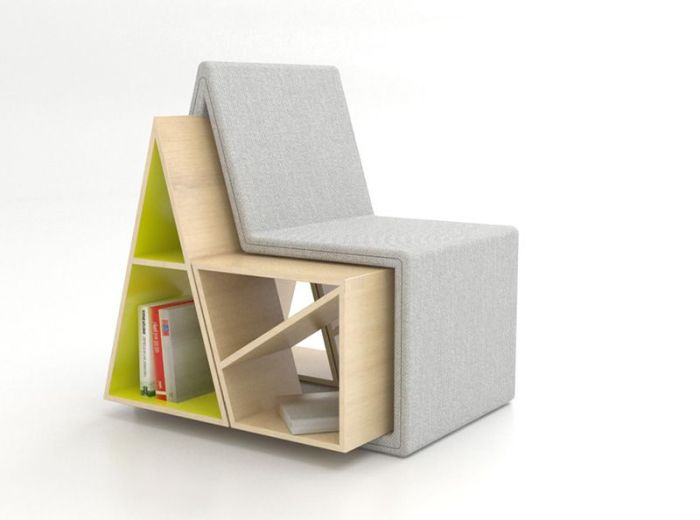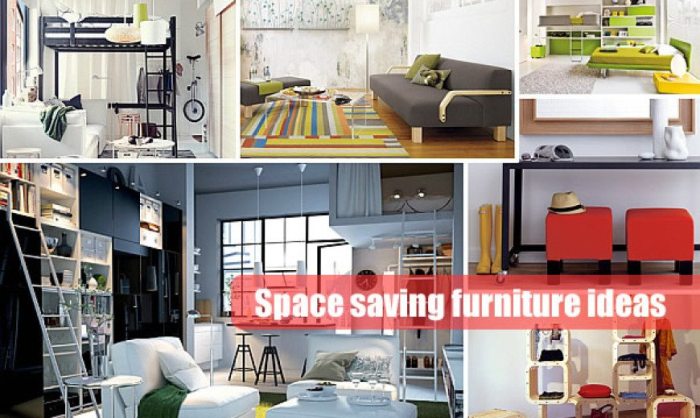Small space furniture with practical design presents a unique challenge and rewarding opportunity. Maximizing functionality within limited square footage requires careful consideration of both aesthetics and utility. This exploration delves into innovative solutions for creating comfortable and stylish living spaces, even in the smallest of homes or apartments. We’ll examine space-saving furniture, clever storage solutions, and design principles that enhance the overall feel of a compact environment.

From cleverly disguised storage ottomans to multi-functional furniture pieces that serve multiple purposes, the possibilities for enhancing small-space living are surprisingly diverse. This discussion will highlight examples of furniture designed specifically for compact spaces, focusing on pieces that offer both practicality and a touch of elegance.

Living in a small space doesn’t mean sacrificing style or comfort. With careful planning and the right furniture choices, you can create a functional and aesthetically pleasing home, even in a limited area. This comprehensive guide explores the world of small space furniture, offering practical design tips and solutions to help you maximize your living area. We’ll delve into various furniture types, clever storage solutions, and space-saving techniques to transform your compact home into a haven of comfort and efficiency.
Understanding the Challenges of Small Space Living
Before diving into furniture solutions, it’s crucial to understand the unique challenges of small space living. Clutter is a significant issue, easily overwhelming a limited area. Furthermore, the need to accommodate multiple functions within a single room requires creative solutions. Poorly chosen furniture can exacerbate these problems, making a small space feel cramped and disorganized. Therefore, careful consideration of furniture size, functionality, and storage capacity is paramount.
Choosing the Right Small Space Furniture: Key Considerations
Selecting furniture for a small space demands a strategic approach. Here are some key considerations:
Size and Scale:
- Measure your space meticulously: Before purchasing any furniture, accurately measure the dimensions of your room and any potential placement areas. This prevents buying pieces that are too large or awkwardly proportioned.
- Prioritize multi-functional pieces: Opt for furniture that serves multiple purposes. A sofa bed, for instance, combines seating and sleeping space. A coffee table with built-in storage provides both a surface and storage capacity.
- Embrace vertical space: Utilize wall space with tall, narrow bookshelves or storage units to maximize storage without taking up valuable floor space. Consider wall-mounted desks or shelves to free up floor area.
Style and Aesthetics:, Small space furniture with practical design
- Light and airy colors: Opt for light-colored furniture and walls to create an illusion of spaciousness. Dark colors can make a small room feel smaller and more confined.
- Minimalist design: Embrace minimalist design principles. Clean lines, simple shapes, and uncluttered surfaces contribute to a sense of openness and spaciousness.
- Mirrors: Strategically placed mirrors can visually expand a room by reflecting light and creating the illusion of depth.
Materials and Durability:
- Lightweight materials: Choose lightweight materials such as bamboo, aluminum, or lightweight wood to avoid making the space feel heavy.
- Durable construction: Invest in well-constructed furniture that will withstand daily use and last for years. This is especially important in small spaces where furniture is used more intensively.
Types of Small Space Furniture
Several furniture types are particularly well-suited for small spaces. Let’s explore some popular options:
Foldable and Convertible Furniture:
- Sofa beds: Offer versatile seating and sleeping arrangements, ideal for guest rooms or studios.
- Murphy beds: Wall-mounted beds that fold away when not in use, maximizing floor space.
- Folding tables and chairs: Easily stored away when not needed, perfect for dining or working areas.
Space-Saving Storage Solutions:
- Ottoman storage: Provides seating and hidden storage for blankets, pillows, or other items.
- Under-bed storage: Utilize the space under your bed with storage containers or drawers.
- Modular shelving units: Customizable shelving systems that can be adapted to fit any space and storage needs.
Multi-Functional Furniture:
- Storage ottomans: Combine seating with storage space.
- Desk with drawers: Provides a workspace and storage for office supplies.
- Coffee tables with drawers: Offer a surface and storage for remotes, books, or games.
Smart Storage Strategies for Small Spaces
Clever storage solutions are crucial for maintaining order and preventing clutter in a small space. Here are some effective strategies:
- Vertical storage: Use vertical space with tall bookshelves, wall-mounted shelves, and hanging organizers.
- Hidden storage: Incorporate hidden storage into furniture pieces like ottomans, coffee tables, and beds.
- Declutter regularly: Regularly declutter your belongings to prevent accumulation of unnecessary items.
- Utilize wall space: Hang shelves, mirrors, and artwork to maximize wall space and create a visually appealing environment.
Frequently Asked Questions (FAQ)
- Q: What are the best materials for small space furniture?
A: Lightweight yet durable materials like bamboo, aluminum, or lightweight wood are excellent choices. Consider the durability and ease of cleaning when making your selection. - Q: How can I make my small space feel bigger?
A: Use light colors, mirrors, and minimalist design. Maximize natural light and avoid cluttering the space. - Q: What type of furniture should I avoid in a small space?
A: Avoid bulky, oversized furniture that dominates the room. Stay away from dark colors and overly ornate designs. - Q: Where can I find small space furniture?
A: Many retailers offer small space furniture, both online and in physical stores. Check out websites like IKEA, Wayfair, and Amazon, as well as local furniture stores. - Q: How important is storage in small space design?
A: Storage is paramount in small space design. Insufficient storage leads to clutter and a cramped feeling. Prioritize multi-functional furniture with built-in storage.
Resources
- Apartment Therapy
-Offers numerous articles and guides on small space living and design. - The Spruce
-Provides comprehensive guides on home decor, including small space solutions. - IKEA
-Offers a wide range of space-saving furniture and storage solutions.
Conclusion
Creating a comfortable and functional home in a small space is achievable with careful planning and the right furniture choices. By prioritizing multi-functional pieces, smart storage solutions, and a minimalist design aesthetic, you can transform your compact living space into a stylish and efficient haven. Remember to measure your space, consider your needs, and embrace the possibilities of creative design to maximize your living area’s potential.

Call to Action
Ready to transform your small space? Start browsing our selection of space-saving furniture today and create the home of your dreams!
Query Resolution: Small Space Furniture With Practical Design
What materials are best for small space furniture?
Lightweight yet durable materials like wood, metal, and certain plastics are ideal. Avoid bulky, heavy pieces.
How can I maximize natural light in a small space?
Use light-colored furniture and decor to reflect light. Keep windows unobstructed and consider mirrors to amplify brightness.
Where can I find affordable small space furniture?

Online marketplaces, thrift stores, and furniture retailers offering budget-friendly lines are good starting points.
